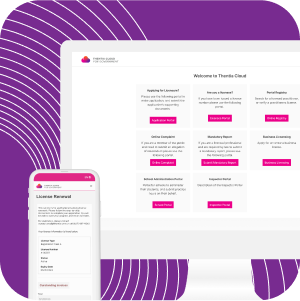- Platform
-
Solutions
-
BY INDUSTRIES
-
-
 See Thentia Cloud In Action
See Thentia Cloud In ActionSee how our platform can drive greater efficiency for your agency.
BOOK A DEMO
-
-
Company
-
COMPANY
-
LIFE AT THENTIA
-
GET IN TOUCH

-
-
Resources
-
RESOURCES
-
WATCH & LEARN
-
SUPPORT
CUSTOMER STORIES
 Hear from regulatory agencies who are using Thentia Cloud and see how it’s transformed their operations. READ MORE
Hear from regulatory agencies who are using Thentia Cloud and see how it’s transformed their operations. READ MORE
-
- Ascend Magazine
When the Oklahoma State Board of Osteopathic Examiners (OSBOE) deployed Thentia Cloud as its first end-to-end digital licensing software solution in late 2019, the state-run agency immediately realized a multitude of valuable benefits – not only for its agile team of staff but importantly for its thousands of existing users and new applicants. Like many professional licensing organizations, OSBOE had become accustomed to countless manual and tedious tasks related to licensing applications and renewals that cost both the agency’s staff and licensees no shortage of time.
But despite multiple change requests over the last several years, OSBOE continued to operate on an archaic renewal-only system implemented more than a decade prior, notwithstanding an obvious need to digitize and streamline its processes.
With a long history as the agency responsible for overseeing osteopathic medicine licensing applicants as well as the adoption of regulations related to the profession, OSBOE was in search of a technology partner with a deep understanding of regulatory licensing to modernize all aspects of its operations beyond just licensing renewals.
A clunky, hard-to-navigate license renewal platform that cost staff and users valuable time
Like many licensing agencies, OSBOE experienced several challenges and pain points before implementing Thentia Cloud, an end-to-end solution to manage all functions captured under the agency’s mandate. But one of its most burdensome challenges that came with its old platform was the sheer amount of time required by staff and licensees for renewals and more importantly, new license registration.
According to Executive Director, Michael Leake, staff routinely spent many hours helping licensees maneuver a complicated, outdated renewal platform that lacked user friendliness. Staff members often fielded phone calls from disgruntled licensees who struggled to navigate the process and needed one-to-one support and guidance. In addition, because the 24-page license application process for new licensees was done completely manually, it often took upwards of multiple weeks to complete given incomplete forms, personal phone calls to applicants requesting forms to be resubmitted, and mail delivery delays. Adding to the frustration were steep overnight shipping costs incurred by applicants in hopes of expediting the process.
Aside from a lack of automation and user friendliness, its former platform also suffered from an overall dearth of functionality. Staff experienced limitations when it came to data extractions, nor could any other function of the business – including managing its complaint and investigation process or overseeing licensee continuing education requirements – be done digitally within a single sophisticated product, much less one designed exclusively for regulatory licensing agencies.





